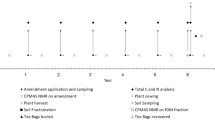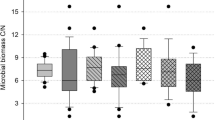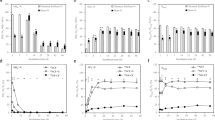Abstract
Long-term experiments on different crop management systems provide essential information about turnover of soil organic matter and changes in microbial properties over a period of time. A long-term field site trial, which was established in 1967 near Vienna, Austria, to document the fate of 14C-labelled manure (straw and farmyard) under different crop management systems (crop rotation, spring wheat and bare fallow), was investigated. Soil samples were taken in 1997 and separated into size fractions (>250 μm, 250–63 μm, 63–2 μm, 2–0.1 μm and <0.1 μm) after aggregate dispersion using low-energy sonication. Organic C, total N and 14C content were measured in the bulk soil and the size fractions and microbial properties were analysed in the bulk soil. Additionally, C mineralization in bulk soil samples was monitored at 20 °C over a period of 28 days, and subsequently 14C-CO2 content was analysed. The distribution of organic C and N within the size fractions was similar between crop rotation and spring wheat; the highest amounts of organic C and N were found in the clay-sized fraction. The amounts of C and N were significantly smaller in the bare fallow, which was depleted of organic matter in the coarse-sized fractions. 14C distribution differed significantly from unlabelled C distribution, labelled C was accumulated in the silt-sized fraction, indicating weak humification of the applied manure C. The highest rate of C mineralization was measured in the crop rotation and spring wheat, whereas the emission rate of the bare fallow was about 40% lower. The higher 14C:C ratio of the bulk soil in comparison to the emitted CO2 indicated that labelled C compounds still remained mineralizable after a period of 30 years. Microbial properties showed a great difference between crop management systems and bare fallow, particularly regarding urease and xylanase activity.
Similar content being viewed by others
Author information
Authors and Affiliations
Additional information
Received: 31 May 1999
Rights and permissions
About this article
Cite this article
Stemmer, M., Roth, K. & Kandeler, E. Carbon mineralization and microbial activity in a field site trial used for 14C turnover experiments over a period of 30 years. Biol Fertil Soils 31, 294–302 (2000). https://doi.org/10.1007/s003740050659
Issue Date:
DOI: https://doi.org/10.1007/s003740050659




